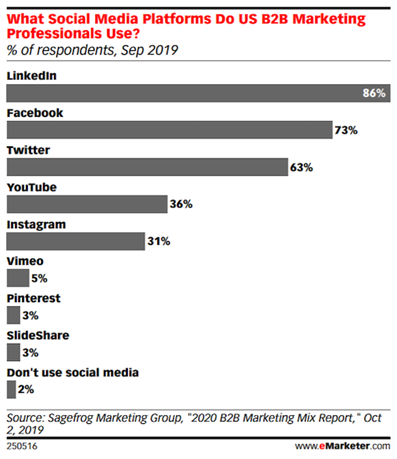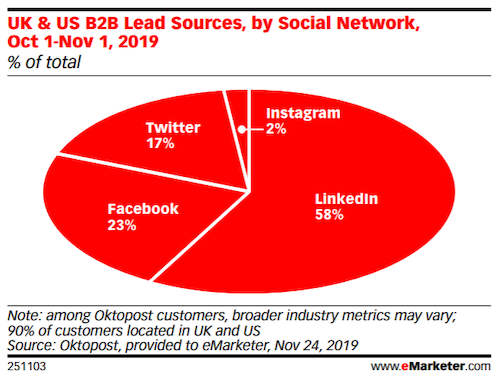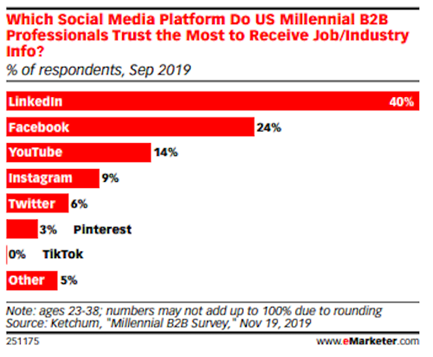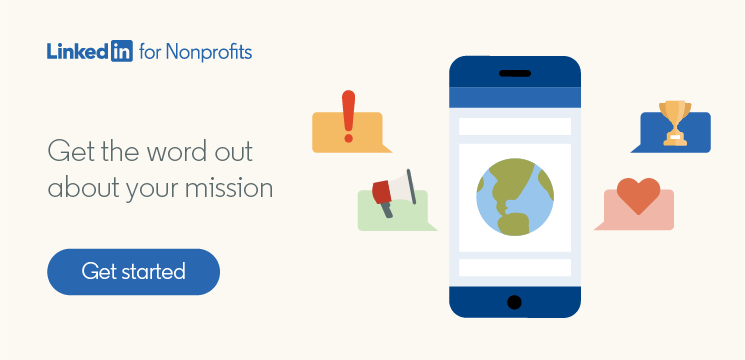
How Nonprofit Marketers Can Engage a Professional Audience on LinkedIn in 2021
As we enter another year that’s likely to be dominated by the COVID-19 pandemic, there’s never been more pressure on nonprofit marketers to reach and engage with potential corporate donors. Luckily, when it comes to winning the hearts and minds of the professional community, don’t have to start from square one: you can adapt many of the same strategies that business-to-business (B2B) marketers have perfected, and learn from the same insights that they thrive on.
To help you get started, this eMarketer report examines some of the ways that marketers can most efficiently and effectively use LinkedIn to meet their goals. Here are some of the key insights from the report—and tips for how you can use them to drive your organization’s next marketing push.
LinkedIn is the most popular social media platform for reaching professional audiences
According to survey data from Sagefrog Marketing Group, LinkedIn is the go-to social media platform for businesses marketing to other businesses.

While you’re not trying to sell a product or service to businesses, you are reaching out to many of the same professionals that B2B marketers target—and these marketers find LinkedIn to be the most effective platform for these efforts.
B2B marketers consider LinkedIn to be the “premier channel” for reaching decision-makers
When it comes to the effectiveness of marketing efforts tailored to corporate audiences, one of the biggest differentiators between LinkedIn and other social media platforms is the kind of people you’re able to reach. Search strategist Hannah Elemary points to the ability to reach a C-suite audience as one of the most important reasons for marketing on LinkedIn over other channels.
“Our clients choose LinkedIn over Facebook and Twitter because it is a place to share thought leadership and industry insights at the executive level,” she says. This applies to nonprofits too: getting your message in front of the right eyes can help you build awareness and interest among both potential corporate donors and the next generation of board members.
Mike Stocker, VP of strategic partnerships at RollWorks, an account-based marketing vendor, seconds Hannah’s assessment of LinkedIn’s audience-specific impact. “[Organizations] today that are trying to reach professionals and other business buyers need to be on LinkedIn,” Stocker says. “LinkedIn has an engaged audience and strong scale. It really is the premier channel for B2B marketing.”
LinkedIn leads the pack in driving leads in the professional world
In 2019, social media management platform Oktopost asked its customers for a breakdown of lead sources. In all, 58% of business leads were sourced from LinkedIn, accounting for more than 2.5x more leads than the next social media platform.
For nonprofit marketers, that means more businesses talking to your organization about sponsorship opportunities and other ways they can help—helping your team reach fundraising targets faster.

Millennials trust LinkedIn for finding information and building lasting connections
According to data from the eMarketer report, LinkedIn is by far the most trusted social media platform among millennial professionals when it comes to finding information about industries, initiatives, and employment, with 40% of respondents rating it as the most trustworthy.

A 2019 survey from Demand Gen Report and The Mx Group, found that this generation uses social media to make connections, get inspired, and educate themselves on topics and initiatives they care about. In fact:
- Nearly two-thirds of respondents browse social media discussions to learn more about a topic
- More than half ask their network for suggestions and recommendations
- 38% connect directly with organizations of interest
- 27% connect with thought leaders for insights and opinions
By using your nonprofit’s LinkedIn page to build awareness with this generation of professionals, you can gain their trust and inform them about your organization’s mission, culture, and social impact. Since millennials are currently the largest generation in the U.S. labor force, it’s also highly likely that you’ll need to reach some of these professionals to foster corporate partnerships—and LinkedIn is the perfect place to do that.
New features make it easier for nonprofit marketers to expand their organic reach on LinkedIn
A 2019 CMI and MarketingProfs survey found that of all North American B2B marketers with a social distribution strategy, 95% use LinkedIn for organic content marketing.
Nonprofit marketers who enrich their audience’s professional lives have long enjoyed the benefits that come with organic reach on LinkedIn. To support this mutually beneficial tradition, LinkedIn recently rolled out new ways for marketers to share more of what their professional peers and prospective donors want. You can drive awareness and action using executive thought leadership, employee advocacy, LinkedIn Live, and many other tools straight from your organization’s LinkedIn Page.
Objective-Based Advertising + audience data = highly focused paid campaigns
With in-person fundraising efforts tabled for the time being, many organizations are likely to ramp up their digital marketing campaigns in 2021. To help streamline the connection between goals and results, LinkedIn launched Objective-Based Advertising, allowing nonprofit marketers to customize goals around three primary objectives: awareness, consideration, and conversion. After deciding on your objective, you can then build audiences and segment messaging based on a broad array of demographic, behavioral, and firmographic data.
You can also take advantage of your existing audience data by using LinkedIn’s Matched Audiences feature to build robust audience segments in minutes. The LinkedIn Insight Tag pixel enhances nonprofit marketers’ ability to understand your audiences, while smartly targeting prospects allows you to make the most of your ad spend.
To learn more about how LinkedIn for Nonprofits can help you to identify, engage, and drive action from professional audiences, speak to one of our Nonprofit Specialists.

